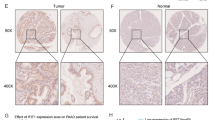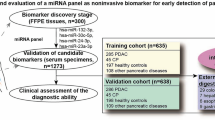Abstract
The Objective is to identify candidate biomarkers for Squamous cell carcinoma (ESCC) in three ethnics in Xinjiang as well as reveal molecular mechanism. Proteins from 15 pairs of ESCC and matching adjacent normal esophageal tissues (five pairs in each ethnic of Kazakh, Uygur and Han) were separated by 2-DE and differentially proteins were identified by matrix-assisted laser desorption/ionization time-of-flight MS. After identified by Mascot database, some of interesting proteins were confirmed in the other 175 pairs of ESCC by immuno histochemistry. Comparison of patterns revealed 20 proteins significantly changed, of which 12 protein with concordantly increased, such as ACTB protein, COMT protein, Syntaxin binding protein Pyruvate Kinase (PKM2), Cathepsin D, Chromosome 1 open reading frame 8, Heat shock protein 27, Cdc42, Proteosome, LLDBP, Immunoglobulin, TNF receptor associated factor 7; and eight protein spots with concordantly decreased intensity in ESCC, such as Adenylate kinase 1, General transcription factor II H, Smooth muscle protein, Trangelin, Early endosome antigen 1, Annexin A2, Fibrin beta, Tropomyosin. There were a significant difference in protein overexpression of PKM2 (74.9%) and Cathepsin D (85.1%) in ESCC compared to adjacent tissues (P < 0.05) by immunohistochemistry. Further, overexpression of Cathepsin D was obvious difference in Hazakh ESCC (94.7%) than that in Uygur (78.6%) (P < 0.05). Interestingly, the overexpression of Cathepsin D was reversely associated with ESCC differentiation (P < 0.05). Twenty proteins differentially-expressed between ESCC and normal tissues were identified. Cathepsin D and PKM2 were for the first time observed to be dysregulated in Kazakh’s ESCC. Moreover, Cathepsin D may play a complicated role both in carcinogenesis and cell-differentiation of ESCC.






Similar content being viewed by others
References
Lambert R, Hainaut P (2007) The multi disciplinary management of gastrointestinal cancer. Epidemiology of oesophagogastric cancer. Best Pract Res Clin Gastroenterol 21:921–945
Tran GD, Sun XD, Abnet CC, Fan JH, Dawsey SM, Dong ZW et al (2005) Prospective study of risk factors for esophageal and gastric cancers in the Linxian general population trial cohort in China. Int J Cancer 113:456–463
Zhang YM (1988) The distribution of esophageal cancer in Xinjiang. Acta Acad Med Xinjiang 11:139–144
Oka M, Yamamoto K, Takahashi M, Hakozaki M, Abe T, Iizuka N et al (1996) Relationship between serum levels of interleukin 6, various disease parameters and malnutrition in patients with esophageal squamous cell carcinoma. Cancer Res 56:2776–2780
Kwong KF (2005) Molecular biology of esophageal cancer in the genomics era. Surg Clin North Am 85:539–553
Enzinger PC, Mayer RJ (2003) Esophageal cancer. N Engl J Med 349:2241–2252
Zhang Q, Wang J, Dong R, Yang S, Zheng S (2010) Identification of novel serum biomarkers in child nephroblastoma using proteomics technology. Mol Biol Rep. doi:10.1007/s11033-010-0149-4
Uemura N, Nakanishi Y, Kato H, Saito S, Nagino M, Hirohashi S et al (2009) Transglutaminase 3 as a prognostic biomarker in esophageal cancer revealed by proteomics. Int J Cancer 124:2106–2115
Looi ML, Karsani SA, Rahman MA, Dali AZ, Ali SA, Ngah WZ et al (2009) Plasma proteome analysis of cervical intraepithelial neoplasia and cervical squamous cell carcinoma. J Biosci 34:917–925
Liu W, Ma Y, Huang L, Peng J, Zhang P, Zhang H et al (2010) Identification of HSP27 as a potential tumor marker for colorectal cancer by the two-dimensional polyacrylamide gel electrophoresis. Mol Biol Rep 37:3207–3216
Borutinskaite VV, Magnusson KE, Navakauskiene R (2010) α-Dystrobrevin distribution and association with other proteins in human promyelocytic NB4 cells treated for granulocytic differentiation. Mol Biol Rep. doi:10.1007/s11033-010-9965-9
Zupanc MM, Wellbrock UM, Zupanc GK (2006) Proteome analysis identifies novel protein candidates involved in regeneration of the cerebellum of teleost fish. Proteomics 6:677–696
Mazurek S, Boschek CB, Hugo F, Eigenbrodt E (2005) Pyruvate kinase type M2 and its role in tumor growth and spreading. Semin Cancer Biol 15:300–308
Wechsel HW, Petri E, Bichler KH, Feil G (1999) Marker for renal cell carcinoma (RCC): the dimeric form of pyruvate kinase type M2 (Tu M2–PK). Anticancer Res 19:2583–2590
Schneider J, Neu K, Grimm H, Velcovsky HG, Weisse G, Eigenbrodt E (2002) Tumor M2–pyruvate kinase in lung cancer patients: immunohistochemical detection and disease monitoring. Anticancer Res 22:311–318
Kaura B, Bagga R, Patel FD (2004) Evaluation of the Pyruvate Kinase isoenzyme tumor (Tu M2–PK) as a tumor marker for cervical carcinoma. J Obstet Gynaecol Res 30:193–196
Schneider J, Schulze G (2003) Comparison of tumor M2–pyruvate kinase (tumor M2–PK), carcinoembryonic antigen (CEA), carbohydrate antigens CA 19-9 and CA 72-4 in the diagnosis of gastrointestinal cancer. Anticancer Res 23:5089–5093
Hardt PD, Toepler M, Ngoumou B, Rupp J, Kloer HU (2003) Measurement of fecal pyruvate kinase type M2 (tumor M2–PK) concentrations in patients with gastric cancer, colorectal cancer, colorectal adenomas and controls. Anticancer Res 23:851–853
Schulze G (2000) The tumor marker tumor M2–PK: an application in the diagnosis of gastrointestinal cancer. Anticancer Res 20:4961–4964
Koss K, Harrison RF, Gregory J, Darnton SJ, Anderson MR, Jankowski JA (2004) The metabolic marker tumour pyruvate kinase type M2 (tumour M2–PK) shows increased expression along the metaplasia–dysplasia–adenocarcinoma sequence in Barrett’s oesophagus. J Clin Pathol 57:1156–1159
Allgayer H, Heiss MM, Schildberg FW (1997) Prognostic factors in gastric cancer. Br J Surg 84:1651–1664
Schwartz MK (1995) Tissue cathepsins as tumor markers. Clin Chim Acta 237:67–78
Vigneswaran N, Zhao W, Dassanayake A, Muller S, Miller DM, Zacharias W (2000) Variable expression of cathepsin B and D correlates with high invasive and metastatic phenotype of oral cancer. Hum Pathol 31:931–937
Allgayer H, Babic R, Grutzner KU, Beyer BC, Tarabichi A, Schildberg FW et al (1997) An immunohistochemical assessment of cathepsin D in gastric carcinoma. Cancer 80:179–187
Breton J, Gage MC, Hay AW, Keen JN, Wild CP, Donnellan C et al (2008) Proteomic screening of a cell line model of esophageal carcinogenesis identifies cathepsin D and aldo-keto reductase 1C2 and 1B10 dysregulation in Barrett’s esophagus and esophageal adenocarcinoma. J Proteome Res 7:1953–1962
Ikeguchi M, Sakatani T, Ueta T, Fukuda K, Oka S, Hisamitsu K et al (2002) Correlation between cathepsin D expression and p53 protein nuclear accumulation in oesophageal squamous cell carcinoma. J Clin Pathol 55:121–126
Acknowledgments
The project was supported by the National Natural Science Foundation (No. 30760223, 30860097) the First Affiliated of Xinjiang Medical University Grant (No. 2008-YFY-01) and Xinjiang Key Laboratory of Molecular Biology and Endemic Diseases Grant (No. XJDX 0208-2009-02).
Author information
Authors and Affiliations
Corresponding author
Additional information
Zan Liu and Jun-guo Feng contributed equally to this work.
Rights and permissions
About this article
Cite this article
Liu, Z., Feng, Jg., Tuersun, A. et al. Proteomic identification of differentially-expressed proteins in esophageal cancer in three ethnic groups in Xinjiang. Mol Biol Rep 38, 3261–3269 (2011). https://doi.org/10.1007/s11033-010-0586-0
Received:
Accepted:
Published:
Issue Date:
DOI: https://doi.org/10.1007/s11033-010-0586-0




